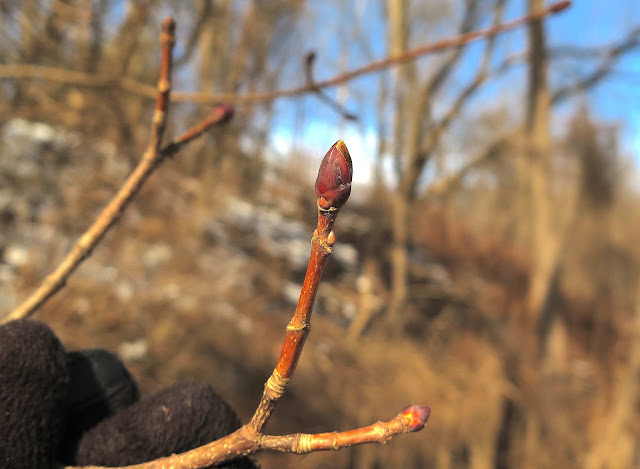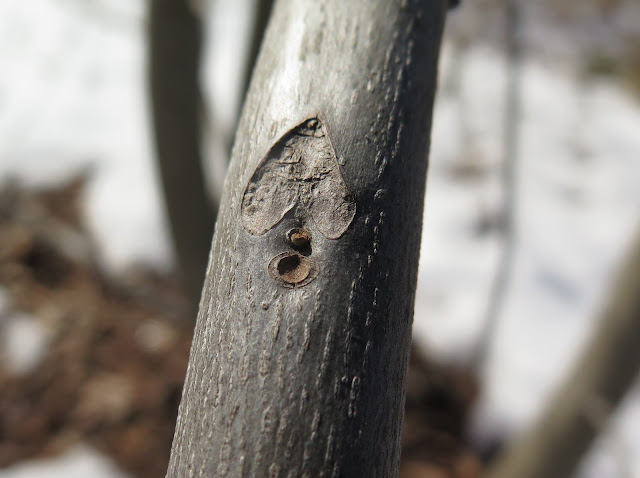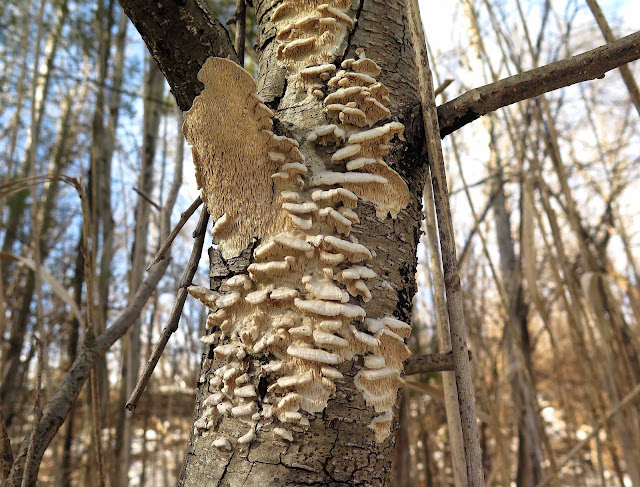The sky was blue. The snow was melting. I had an hour in an otherwise busy day, and lucky for me, a really nice paved and plowed trail lay right across the street from where my errands had taken me on Saturday: the Spring Run Trail in the heart of Saratoga Springs. I could take a quick and pleasant walk, and I didn't even have to change my footwear.
Official Spring may still be more than a week away, but the dogwood shrubs were already dolled up in celebratory color. I could see from the pin dots decorating the scarlet bark of this tangled mass of shrubbery that this was Red Osier Dogwood (Cornus sericea).
And here was an equally red (but solitary) branch of Silky Dogwood (Cornus amomum) leaning over the stream. If you could see the bark up close, you would notice the lengthwise lenticels instead of pin dots.
The Box Elder bark was also flaunting spring color, at least on its newer twigs. And this color is the palest blue, literally a "powder blue," since the powdery bloom on the twigs can easily be rubbed off to reveal redder twigs beneath. Note the opposite buds, a feature of all maple trees and very few other tree species. Yes, Box Elder (Acer negundo) is indeed a maple, although its compound leaves look more like those of ash trees.
And right on cue, another full-size tree with opposite branching, a White Ash (Fraxinus americana), was standing nearby. I noticed first the fat red buds that were studding some of the low-hanging branches.
And then my gaze took in the tall straight White Ash trunk with bark that looks like wide-wale corduroy.
Every spring I notice this smooth-barked young tree with distinctive heart-shaped bud scars and big terminal buds. I think it may be a Pignut Hickory (
Carya glabra), but I always forget to come back later when the tree is in leaf or fruit, to have my guess either confirmed or not. Informed suggestions are always welcome!
Ambling along, I soon approached a trailside ditch filled with mud and standing water. Poking up out of that mud were more sure signs that Spring was fast approaching: many swelling spathes of our first flower of Spring, the Eastern Skunk Cabbage (Simplocarpus foetidus). Most were a mottled red color, but this big fat one was yellow.
I confess in my eagerness to discover the state of the spadix within, I inadvertently fractured this redder spathe of another Skunk Cabbage plant. Well, at least now I could plainly see that the plant was fully in bloom!
And oh my gosh, LOOK! The first flower of Spring that actually looks like a flower! One solitary sun-yellow bloom of Coltsfoot (Tussilago farfara) had pushed up through the still-cold leaf-littered mud in a sun-warmed swale by the creek. In a day or two (if not covered by the deep snow predicted this coming week), this brave little bloom will be surrounded by a whole carpet of its fellows. Ta da!
As I approached the trailside stone walls my friends and I had studied quite carefully for mosses, lichens, and liverworts about a week ago, I wondered if anything had changed since our last examination. So I moved in for a closer look.
Well, the leaves of this Fissidens sp. looked a bit more frayed from frost, but some cute little red spore stalks appeared to have popped up since I last looked closely at this patch. Or did I just miss seeing them before? What time of year does Pocket Moss usually send up its fruiting bodies?
This nice clump of Plagiomnion moss looked about the same, its tri-colored spore stalks still as sprightly and vivid as they'd seemed a week ago.
Oh gosh, last week I must have missed this clump of lime-green long-leaved moss, nestled up against some darker-green Fissidens. Maybe it hadn't yet sent up its wispy spore stalks the last time I searched these rocks. I have no idea what its name may be.
I don't know the name of this posy-shaped moss, either. It must have been really pretty before the winter gnawed its "petal-like" leaves back. The dark mid-vein looks rather distinctive, so maybe a friend will recognize it and tell us what its name is.
Most fungi-covered fallen logs were still buried under snow, but this fungus was high and dry on a standing trunk. I believe it's the one called Milk-white Toothed Polypore (Irpex lacteus). Had it been here all winter and I just missed seeing it? How wonderful that every walk, even along the same path, can yield new treasures on every visit!

















2 comments:
A year ago I posted that Hickory to iNaturalist and our friend Andrew suggested Mockernut ... although subsequent comments (scroll along to read them all) by no means reach a consensus !
https://www.inaturalist.org/observations/108837582
I sure do look forward to seeing these mosses with you again! I think your posey moss could be Rhodobryum ontariense. It's hard to tell with the leaf burn?? I'm thinking your first Fissidens could be Fissidens dubius. The capsules look right, but I'd have to see it under a microscope to be sure.
See You Soon!
Post a Comment